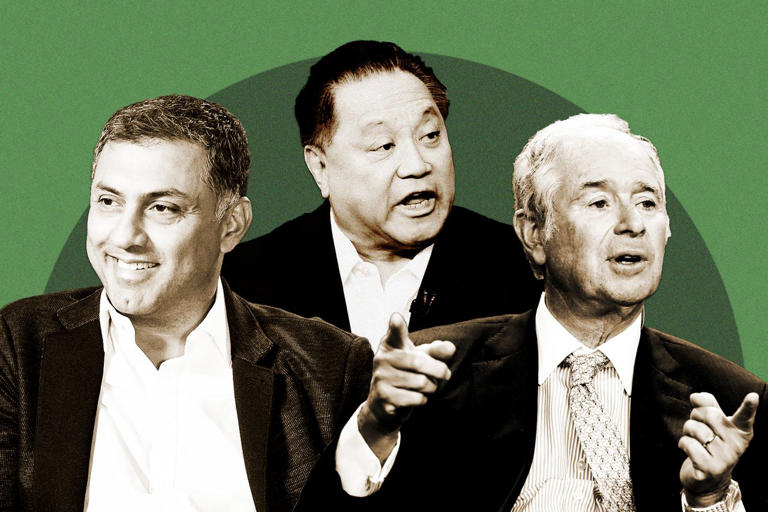In 2023, the compensation packages for the CEOs of America’s largest companies reached unprecedented levels, driven primarily by substantial increases in stock awards. According to an analysis by the Wall Street Journal, the median pay for these top executives hit a record high of $15.7 million, marking a significant rise from the previous year’s median of $14.5 million. Several CEOs saw their total compensation surpass $50 million, reflecting a broader trend of escalating executive pay, influenced by the performance of their companies and the overall market conditions.
Among the most highly compensated executives, Hock Tan of Broadcom emerged as the top earner with a staggering $162 million. However, this massive compensation package comes with stringent conditions. Tan must remain with the company for at least five years, and Broadcom’s share price must hit specific targets after October 2025 for him to fully realize the value of his pay. Broadcom justified this compensation by highlighting its outperformance under Tan’s leadership since 2006 and the fact that he will not receive additional equity or cash bonuses for the next five years. This pay structure is intended to ensure long-term commitment and align his interests with those of the shareholders.
Similarly, Nikesh Arora, CEO of Palo Alto Networks, received $151 million, largely in equity awards spread over three years. This substantial compensation underscores the emphasis on equity-based incentives that are contingent on the company’s performance over time. The trend of significant equity-based compensation was also evident at Blackstone, where CEO Steven Schwarzman earned $120 million. Blackstone noted that its 83% total return in the previous year outpaced other U.S. asset managers, emphasizing that its pay structure is designed to align executive incentives with those of investors, ensuring that the executives’ financial interests are directly tied to the company’s success.
Christopher Winfrey of Charter Communications also saw his compensation package swell, reaching $89.1 million. This included options and stock vesting over five years, with much of it contingent on the company’s shares rising by 28% to 152% from the time the grants were made. This structure is designed to incentivize long-term performance and ensure that executives remain focused on driving shareholder value. Will Lansing of Fair Isaac benefited from a $30 million one-time retention and leadership award, which contributed to his total pay of $66 million. The company pointed out that its shareholder returns ranked among the top 1% of S&P 500 companies over the past decade, justifying the substantial compensation.
The primary driver behind these soaring compensation packages has been equity awards, which make up the bulk of most executives’ pay. These awards are structured to deliver more stock or options if companies meet specific financial or share-price performance criteria over several years. This means the value of the pay can significantly fluctuate based on the company’s performance. For example, Jensen Huang, CEO of Nvidia, saw the value of his restricted stock quadruple through late January 2023, bringing his pay package to $107.5 million, up from the originally reported $34.2 million. This significant increase reflects the company’s strong market performance and its impact on equity-based compensation.
Similarly, Brian Niccol, CEO of Chipotle Mexican Grill, saw his stock and options granted in February 2023 triple in value by the end of the year, from $15.5 million to $52.2 million. This surge was attributed to Chipotle’s strong share-price performance, which saw a return of about 65% during 2023. A Chipotle spokeswoman noted that the growth in Niccol’s equity-award value reflects the company’s strong share-price performance during the year, emphasizing that the ultimate value realized by Niccol depends on the company’s continued financial, operating, and stock-market performance.
Intel CEO Patrick Gelsinger’s equity awards also more than tripled in value by year-end, reaching $39.3 million. Despite these increases in equity value, median cash pay for CEOs, including salary and annual bonuses, remained flat at around $3.8 million. This indicates a shift towards equity-based compensation as a more significant component of executive pay, aligning their financial outcomes more closely with the long-term performance of their companies.
The Wall Street Journal’s analysis also revealed that the pay for CEOs at the best-performing companies did not significantly differ from those at the worst-performing companies. Median total pay was $14.6 million for the 20% of CEOs whose companies recorded the worst returns compared with other companies in the same sector, and $15.7 million for CEOs at the best-performing companies. This suggests that while company performance influences pay, the compensation packages are structured in a way that maintains high levels regardless of performance to some extent.
Among the best-performing companies, Royal Caribbean Group reported a total return of 162% last year, boosting CEO Jason Liberty’s compensation to $17.2 million. This highlights how performance incentives can significantly enhance executive pay packages. Uber Technologies also showed significant recovery, with a 149% return, following previous years of negative returns. These cases demonstrate the potential for substantial pay increases tied to market performance and recovery from downturns.
In contrast, the healthcare sector, particularly pharmaceutical and biotech companies, featured prominently among the worst-performing companies. Pfizer, for instance, did not pay bonuses to top executives due to weak demand for Covid-related products, affecting CEO Albert Bourla’s compensation. This highlights how sector-specific challenges can impact executive pay structures and outcomes.
The data for this analysis was collected from corporate proxy statements filed through May 16 by companies in the S&P 500 index with fiscal years ending after June 30, 2023. The figures reflect the value of equity awards at grant, as reported by companies, and total returns that account for stock-price change and dividends. This comprehensive analysis underscores the growing disparity in executive compensation and the significant role of equity awards in driving CEO pay, reflecting broader trends in corporate governance and executive compensation strategies.
